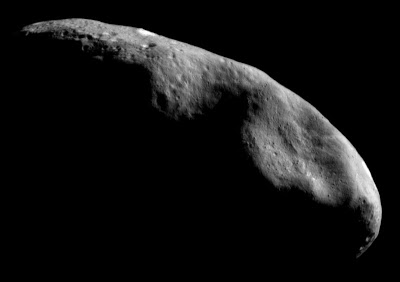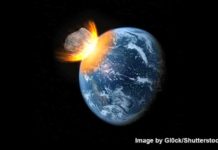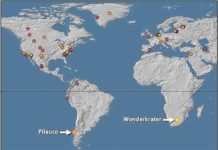
The prospects of a robotic manufacturing base operating off Earth is not as far-fetched as it used to be according to a study published by a team of NASA researchers led by a Kennedy Space Center physicist.
Because asteroids are loaded with minerals that are rare on Earth, near-Earth asteroids and the asteroid belt could become the mining centers for remotely operated excavators and processing machinery. In 20 years, an industry barely imagined now could be sending refined materials, rare metals and even free, clean energy to Earth from asteroids and other bodies.
In their paper called “Affordable, Rapid Bootstrapping of the Space Industry and Solar System Civilization,” published in the Journal of Aerospace Engineering, Phil Metzger, Anthony Muscatello, Robert Mueller and James Mantovani detail an intriguing path toward developing a self-sustaining, space-based industry that would use resources from asteroids and other heavenly bodies to meet the needs of humanity.
The result would provide the most profound societal changes since the Industrial Revolution introduced large-scale machinery and manufacturing techniques in the late 18th and early 19th centuries, said Metzger the Kennedy-based physicist who led the evaluation.
“We’re predicting that we are on the verge of the next revolution in human civilization,” Metzger said.
Two fundamental developments make this prospect possible: robotics and the discovery of fundamental elements to make plastic and rubber and metals existing throughout space.
“Now that we know we can get carbon in space, the basic elements that we need for industry are all within reach,” Metzger said. “That was game-changing for us. The asteroid belt has a billion times more platinum than is found on Earth. There is literally a billion times the metal that is on the Earth, and all the water you could ever need.”
Another critical technology also is coming in at just the right time: additive manufacturing in the form of 3D printers that can turn out individual pieces that can be assembled into ever-more-complex machinery and increasingly capable robots.
“The idea is you start with resources out of Earth’s gravity well in the vicinity of the Earth,” Metzger said. “But what we argued is that you can establish industry in space for a surprisingly low cost, much less than anybody previously thought.”
The finished minerals could be returned to Earth or used in space to build new machinery or as supplies for astronauts as they explore the solar system.
So where to start?
The closer to Earth, the better — at least at first.
NASA is searching for an asteroid of about 500 tons that can be moved into a path within the moon’s orbit so astronauts can visit it as early as 2021 to take samples of the space rock.
“When we wrote this paper we were focused on the moon as a source of near-Earth resources, but near Earth asteroids work equally well and offer several additional advantages,” Metzger said. “It takes less fuel to bring resources away from the lower gravity of an asteroid, and since the ultimate goal is to move the industry to the asteroid main belt starting with asteroids first will help develop the correct technologies.”
But all asteroids are not created equal, and each one is likely to offer a unique fingerprint of substances created when the solar system formed billions of years ago.
“There are some types of asteroids that would be fantastic for space resources,” Metzger said. “It’s primordial solar system material. You can make plastics and you can make rubber by combining the carbon and the hydrogen.”
A near-Earth asteroid or other nearby body presumably will contain enough material to allow a robotic system to mine the materials and refine them into usable metal or other substances. Those materials would be formed into pieces and assembled into another robot system that would itself build similar models and advance the design.
“The first generation only makes the simplest materials, it can include metal and therefore you can make structure out of metal and then you can send robots that will attach electronics and wiring onto the metal,” Metzger said. “So by making the easiest thing, you’ve reduced the largest amount of mass that you have to launch.”
The first generation of machinery would be akin to the simple mechanical devices of the 1700s, with each new generation advancing quickly to the modern vanguard of abilities. They would start with gas production and the creation of solar cells, vital for providing a power source.
Each new robot could add improvements to each successive model and quickly advance the mining and manufacturing capabilities. It would not take long for the miners to produce more material than they need for themselves and they could start shipping precious metals back to Earth, riding on heat shields made of the leftover soil that doesn’t contain any precious material.
Kennedy researchers already have tested heat shield samples made from soil.
Bodies near Earth also were recently revealed to contain water ice, which gives planners the chemicals needed to produce fuel and air. With those resources available, the robotic miners would be able to propel themselves farther out into the solar system, mainly to the resource-rich asteroid belt between Mars and Jupiter. There they could set up more manufacturing and refining facilities.
Perhaps the most unusual aspect of the whole endeavor is that it would not take many launches from Earth to achieve. Launch costs, which now run at best $1,000 per pound, would be saved because robots building themselves in space from material gathered there wouldn’t need anything produced by people. Very quickly, only the computer chips, electronics boards and wiring would need to come from Earth.
“We took it through six generations of robotic development and you can achieve full closure and make everything in space,” Metzger said. “We showed you can get it down to launching 12 tons of hardware, which is incredibly small.”
For comparison, that would be less than half the weight of the Apollo command and service modules flown on a moon mission.
This enterprise would take years to establish, but not as long as one might think. And the payoff for Earth would be felt when the first shipments of materials began arriving from space. A sudden influx of rare metals, for instance, would drive down the price of those materials on Earth and allow a similar drastic reduction in manufacturing costs for products made with the materials.
There are numerous examples of such revolutions taking place over and over again on Earth, including the discovery after the Civil War of a process for refining bauxite into aluminum that made the metal go from being as valuable as gold to something soda cans are made of. Does that mean soda cans would be made from platinum? Maybe not, but the changes could be just as dramatic.
“You could grow an industry that is a million times bigger than the United States’ in the main asteroid belt,” Metzger said. “Then you really are capable of terraforming planets and doing all the other great things because it wouldn’t cost you anything” in terms of labor, resources or materials.
Reference:
Philip T. Metzger, Anthony Muscatello, Robert P. Mueller, James Mantovani. Affordable, Rapid Bootstrapping of the Space Industry and Solar System Civilization. Journal of Aerospace Engineering, 2013; 26 (1): 18 DOI: 10.1061/(ASCE)AS.1943-5525.0000236
Note : The above story is reprinted from materials provided by NASA.










